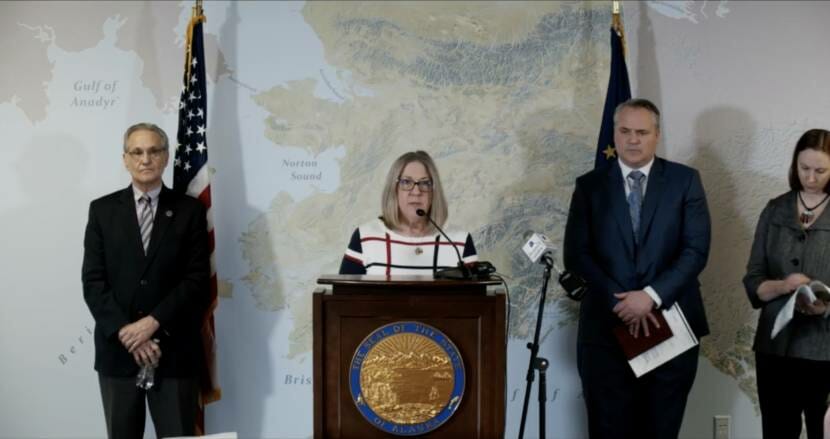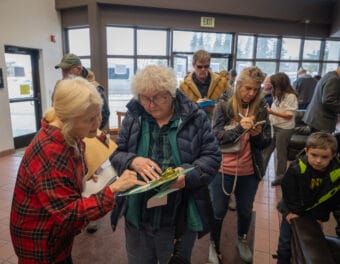
Alaska’s sole seat in the U.S. House of Representatives is vacant following the death of Rep. Don Young. Under the U.S. Constitution, vacancies in the House of Representatives must be filled by elections.
There will be two special elections this summer to fill that vacancy: a special primary election by mail on June 11 and a special election to pick the winner on Aug. 16. That date coincides with Alaska’s regular primary election day and will be conducted the usual way with a mix of in-person and absentee voting.
Gov. Mike Dunleavy said he will issue a proclamation on Tuesday or Wednesday setting the election dates.
State Division of Elections Director Gail Fenumiai said the timing allowed the state to avoid holding yet another election date.
“The main concern is having this special primary election timely enough to get it certified, so the race can appear on the Aug. 16 primary election, so we would not be forced with doing yet another special election,” she said during a news conference on Tuesday.
Since the June 11 special primary is coming up so quickly, that election will be held by mail.
The deadline for candidates to file to fill the vacancy is April 1. This date was picked to allow the Division of Elections enough time to print and mail absentee ballots to military and other voters who are overseas.
The timeframe for setting the special primary and special election was set by a ballot measure Alaska voters approved in 2020. The ballot measure instituted the new open primary and ranked choice general election system.
Voters will vote for one candidate in the special primary, which will be open to candidates from all political parties. Under Alaska’s new election system, the four candidates who get the most votes will be on the final special election ballot. That election will be the first conducted under the state’s new ranked choice voting system.
On Aug. 16, two elections will be on the ballot. In the special election, voters will be ranking four candidates to fill the final months of Don Young’s term. But in the open primary for the next two-year term, voters will only be voting for one candidate to determine the top four that will advance to the Nov. 8 ranked-choice general election. The same candidates can run in both elections.
Lt. Gov. Kevin Meyer, who oversees elections, said the Division of Elections will work to inform voters about both the special elections and the new system.
Meyer and division director Gail Fenumiai determined that the main way of voting for the June 11 special primary will be by mail, and every registered voter will have a ballot mailed to them.
“The vote-by-mail option is pretty much the only way we can go and still have a successful primary special election,” Meyer said.
Meyer attributed the decision due to the short timeframe. At least some voters won’t know what district they’re in and where their polling place is until Alaska Supreme Court decides the outcome of lawsuits challenging the state’s new legislative district lines. That must happen by April 1.
“So we don’t know districts yet entirely, the general public doesn’t know their districts yet, and or where their new voting places will be,” he said.
Meyer also said it would have been difficult to recruit enough poll workers to hold the special primary in the usual fashion.
Voters will still have the option of voting in person at regional Division of Elections offices early or on the special election day. But most polling places will be closed. State law allows for this type of election to be conducted by mail.
Both the voter and a witness will be required to sign the envelope for the mail-in ballots, Meyer said.
The special election on the Aug. 16 regular primary day will be conducted in the normal manner, with polling places open and voters able to cast absentee ballots without giving a reason. The seat will remain vacant until Sept. 2, when the primary election results will be certified. The results of the election may not be known until 15 days after the election, the deadline for overseas ballots mailed by the election day to arrive, due to the complications of counting ranked choice ballots.
Meyer acknowledged the challenges involved in this year’s election. He ticked the hurdles off, one by one:
- Holding the June 11 special primary election, as well as the special election on the regular Aug. 16 primary day and the Nov. 8 general election;
- Hiring enough poll workers;
- Buying paper ballots at a time of a national paper shortage and supply-chain difficulties;
- Informing voters about new district boundaries and, for many, polling locations;
- Answering voter questions about the once-per-decade question on whether to hold a constitutional convention; and
- Dealing with the ongoing COVID-19 pandemic.
“We have a lot of challenges this year, probably the toughest year — that I know of anyway — to have elections,” he said. “But Gail and her crew are ready, prepared and we’re going to have good elections.”



